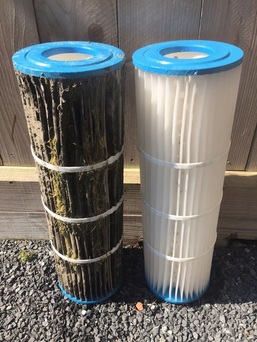We'd like to start today's entry with a warning: This will not be the most exciting thing you'll read today. Pool nerds like us do find it fascinating but we know that's not the case for the average swimming enthusiast. But bear with us, because it is good to know how these things work and what to look out for. If you keep reading, you'll be rewarded with adorable dog and kitty photos. So read on, good friends!
One of the most essential elements to any swimming pool is the component that helps to filter out debris; aptly named, the filter. Filters remove fine suspended particles from the water through a screening process. As the water passes through the filtering material, or media, fine particles are collected within. The size of the particles trapped can be determined by a filter's micron rating, respectively.
Microns represent the average size openings between pieces of the filter and filter media that have potential to allow particles through. The bigger the micron number, the bigger the particles that will be allowed to pass. Most filters have micron ratings of anywhere from 3 to 20. For perspective, a human hair is 50 microns, and the human eye cannot see anything smaller than 40 microns.
One of the most essential elements to any swimming pool is the component that helps to filter out debris; aptly named, the filter. Filters remove fine suspended particles from the water through a screening process. As the water passes through the filtering material, or media, fine particles are collected within. The size of the particles trapped can be determined by a filter's micron rating, respectively.
Microns represent the average size openings between pieces of the filter and filter media that have potential to allow particles through. The bigger the micron number, the bigger the particles that will be allowed to pass. Most filters have micron ratings of anywhere from 3 to 20. For perspective, a human hair is 50 microns, and the human eye cannot see anything smaller than 40 microns.
Sand filters have the longest time between cleanings, but the largest micron rating. Sand can remove particles as low as 20 microns. Backwashing a sand filter should be performed once a month, or when the pressure rises by 10 psi, but the sand only needs to be changed every 3-5 years. Sand filters are more commonly found in commercial applications, but are found on residential pools as well.
The cartridge filter requires no extra media installation. The cartridges themselves filter down to 5 microns and offer water clarity that surpasses that of a sand filter. This type of filter has no backwash option and should be cleaned at least twice a year. The cartridges can last anywhere from three to seven years depending on various factors.
The cartridge filter requires no extra media installation. The cartridges themselves filter down to 5 microns and offer water clarity that surpasses that of a sand filter. This type of filter has no backwash option and should be cleaned at least twice a year. The cartridges can last anywhere from three to seven years depending on various factors.
The diatomaceous earth (DE) filter is the best when it comes to capturing particles. DE powder is made from the fossilized remains of tiny aquatic organisms called diatoms. The powder acts like sand catching particles but on a much smaller scale. DE is able to trap particles as small as 3 microns, which offers the clearest water out of the three filters we’ve discussed here. DE filters require backwashing once a month or when the pressure rises by 10 psi, and a full clean and inspection at least once per year.
Regular cleaning of any filter will offer the best water clarity and pool water circulation. Cleaning the filter will wash away all the trapped debris and particles to allow a fresh start and several more months of working hard to keep your water clean.
Regular cleaning of any filter will offer the best water clarity and pool water circulation. Cleaning the filter will wash away all the trapped debris and particles to allow a fresh start and several more months of working hard to keep your water clean.
Ah, now here's the real payoff. Just look at that beautiful before and after.




 RSS Feed
RSS Feed